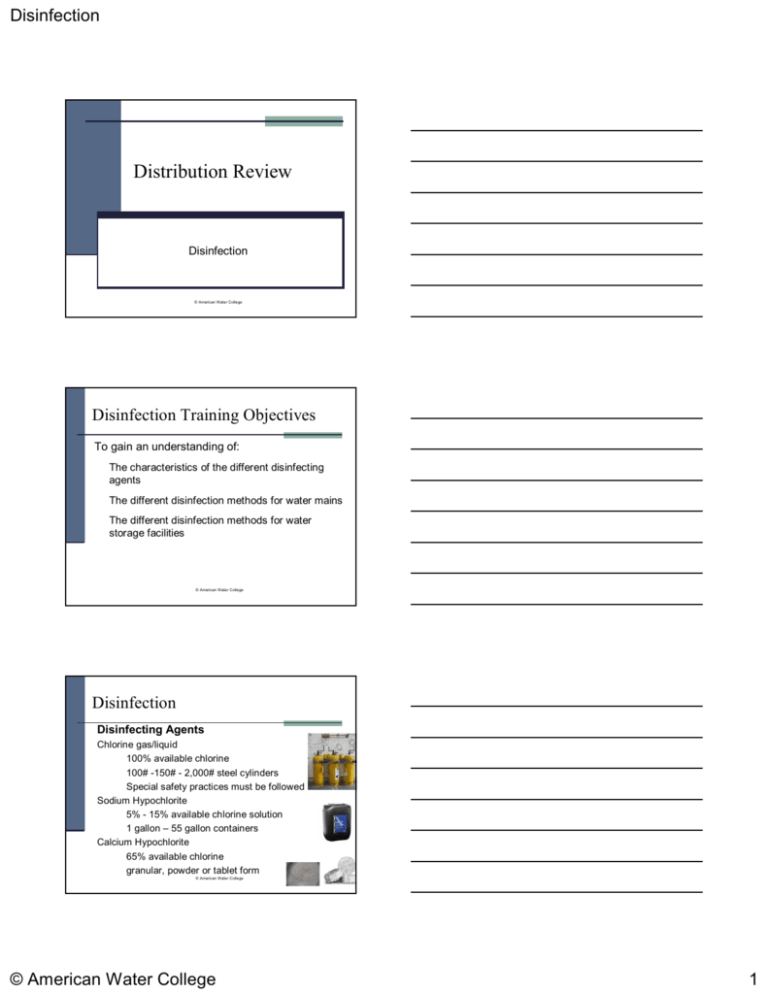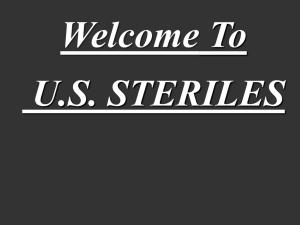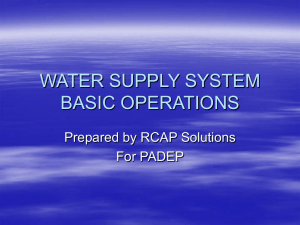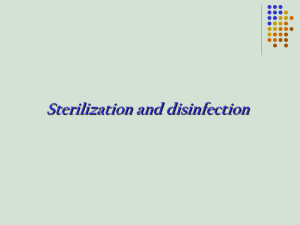Lesson Handout - American Water College
advertisement

Disinfection Distribution Review Disinfection © American Water College Disinfection Training Objectives To gain an understanding of: The characteristics of the different disinfecting agents The different disinfection methods for water mains The different disinfection methods for water storage facilities © American Water College Disinfection Disinfecting Agents Chlorine gas/liquid 100% available chlorine 100# -150# - 2,000# steel cylinders Special safety practices must be followed Sodium Hypochlorite 5% - 15% available chlorine solution 1 gallon – 55 gallon containers Calcium Hypochlorite 65% available chlorine granular, powder or tablet form © American Water College © American Water College 1 Disinfection Disinfection Factors Affecting Disinfection Temperature – higher is better pH – lower is better Turbidity – lower is better Chlorine dose – higher is better Contact time – longer is better Tuberculation – lower is better Biological growth – less is better © American Water College Disinfection Distribution System Chlorine Residual Residual – the chlorine concentration once the chlorine demand has been met Demand – difference between the dose and residual A residual should be maintained in the system because contamination can happen at any time Residual range – 0.2 mg/L to 4.0 mg/L Measured in the field with DPD method Dead ends and zones with high water age are difficult to maintain a chlorine residual © American Water College Disinfection Disinfecting Mains Three methods commonly used: Tablet method Continuous feed method Slug method AWWA Standard C651-99 © American Water College © American Water College 2 Disinfection Disinfection Disinfecting Mains Tablet Method: Best suited for short sections of pipe (few hundred feet) Best on small diameter pipes (24 inches or less) As pipe is laid in a trench, tablets are placed in each section with an approved adhesive on the top of the pipe Sufficient tablets are added to give a dose of 25 – 50 mg/L Pipe is slowly filled with water to prevent washing away chlorine tablets (< 1 fps) Water is left for 24 hours (48 hrs. if water < 41oF) Monitor to ensure residual is greater than 25 mg/L throughout the pipe © American Water College Disinfection Disinfecting Mains Continuous feed Method: Preliminary flushing at 2.5 fps or greater is required (5 fps is preferred) Solution of at least 25 mg/L free chlorine injected into pipe as it is being filled Added at a rate to ensure a 10 mg/L residual will remain in all portions of the system at the end of a 24 hour period © American Water College Disinfection Disinfecting Mains Slug Method: Used for long, large diameter mains Reduces the amount of chlorinated water to be flushed Calcium hypochlorite tablets are placed in the main during construction Fill water main for initial dose to meet initial demand Then, using the continuous feed method, dose to produce a concentration of 100 mg/L (C651-92 required 300 mg/L) Feed to produce a long slug of 100 mg/L water which will contact all interior surfaces of the pipe for 3 hours Monitor to ensure > 50 mg/L – re-dose if necessary © American Water College © American Water College 3 Disinfection Disinfection Disinfecting a Main With the Slug Method Cl2 3 hours > 50 mg/L 100 mg/L © American Water College Disinfection Disinfecting Mains Monitoring After required contact time, measure residual to ensure adequate chlorine concentration remains. Flush system to lower residual to less than 4 mg/L (< 2 mg/L is preferred for taste concerns) Sample for coliform bacteria with the P-A method Once bacteria results are negative, system can be put in service © American Water College Disinfection Disinfecting Storage Tanks Three methods commonly used: Complete fill Surface spray Partial fill AWWA Standard C652-92 © American Water College © American Water College 4 Disinfection Disinfection Disinfecting Storage Tanks Method 1 - Complete Fill Storage tank is filled to overflow level with potable water and enough chlorine to result in a 10 mg/L residual When gas is used, required contact time is 6 hours When hypochlorite is used, contact time is 24 hours Residual is reduced to 2 mg/L following contact time Coliform samples taken prior to placing tank in service © American Water College Disinfection Method 1 - Complete Fill 10 mg/L Cl2 © American Water College Disinfection Disinfecting Storage Tanks Method 2 - Surface Spray All surfaces that may contact water are coated with a 200 mg/L chlorine solution. Minimum contact time is 30 minutes Following contact time, tank is filled with potable water to the overflow pipe Coliform samples taken prior to placing tank in service © American Water College © American Water College 5 Disinfection Disinfection Disinfecting Storage Tanks Method 3 - Partial Fill Fill storage tank to 5% of total capacity Add enough chlorine to bring residual to 50 mg/L Hold for at least 6 hours Fill tank to overflow level with chlorinated water and hold for 24 hours Residual must be at least 2 mg/L after 24 hours Coliform samples taken prior to placing tank in service © American Water College Disinfection Method 3 - Partial Fill 2 mg/L after 24 hours Cl2 50 mg/L Hold for 6 hours © American Water College Review the lecture handout and then complete the quiz. This will help you remember the information we just covered. © American Water College © American Water College 6




